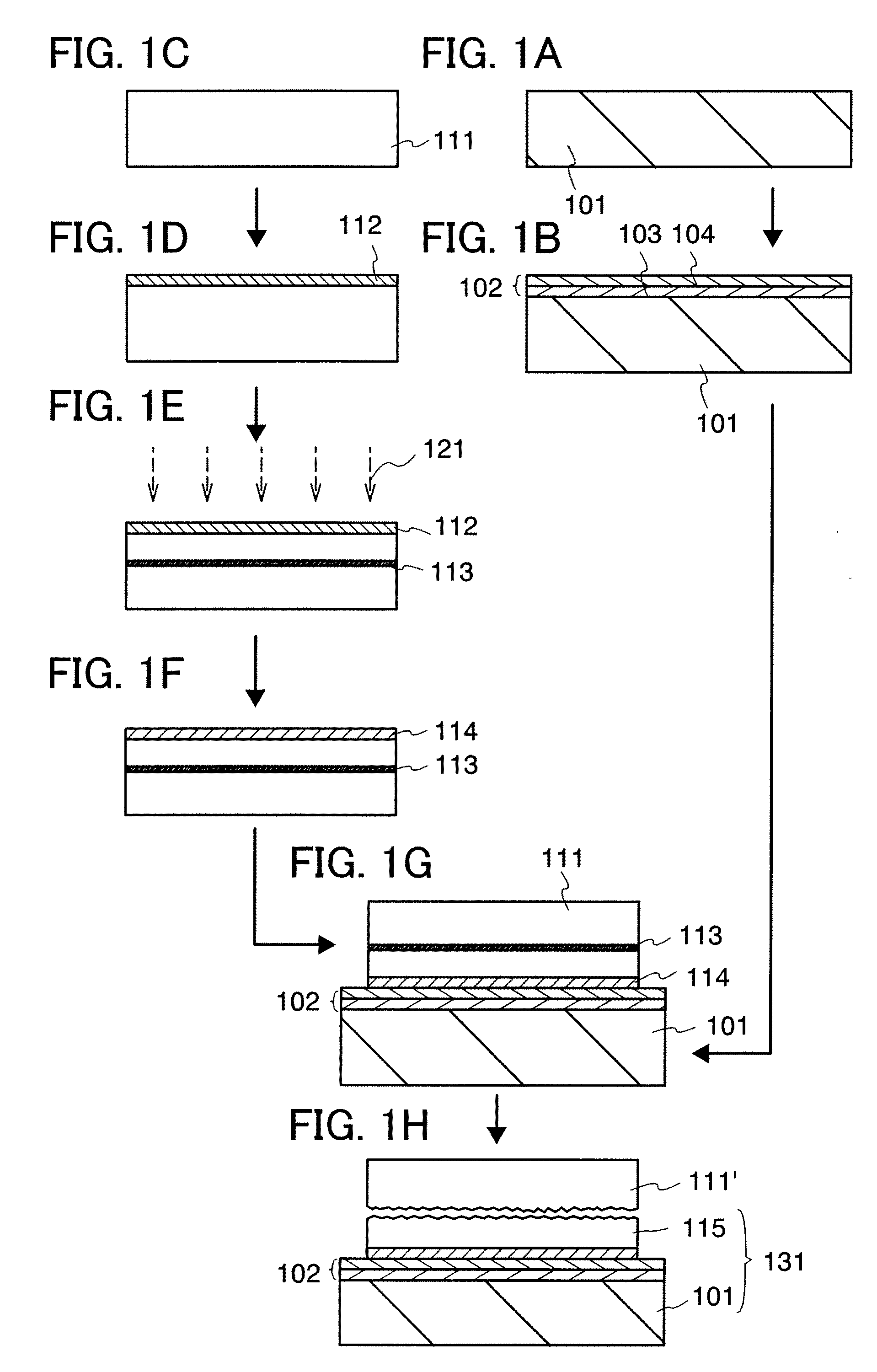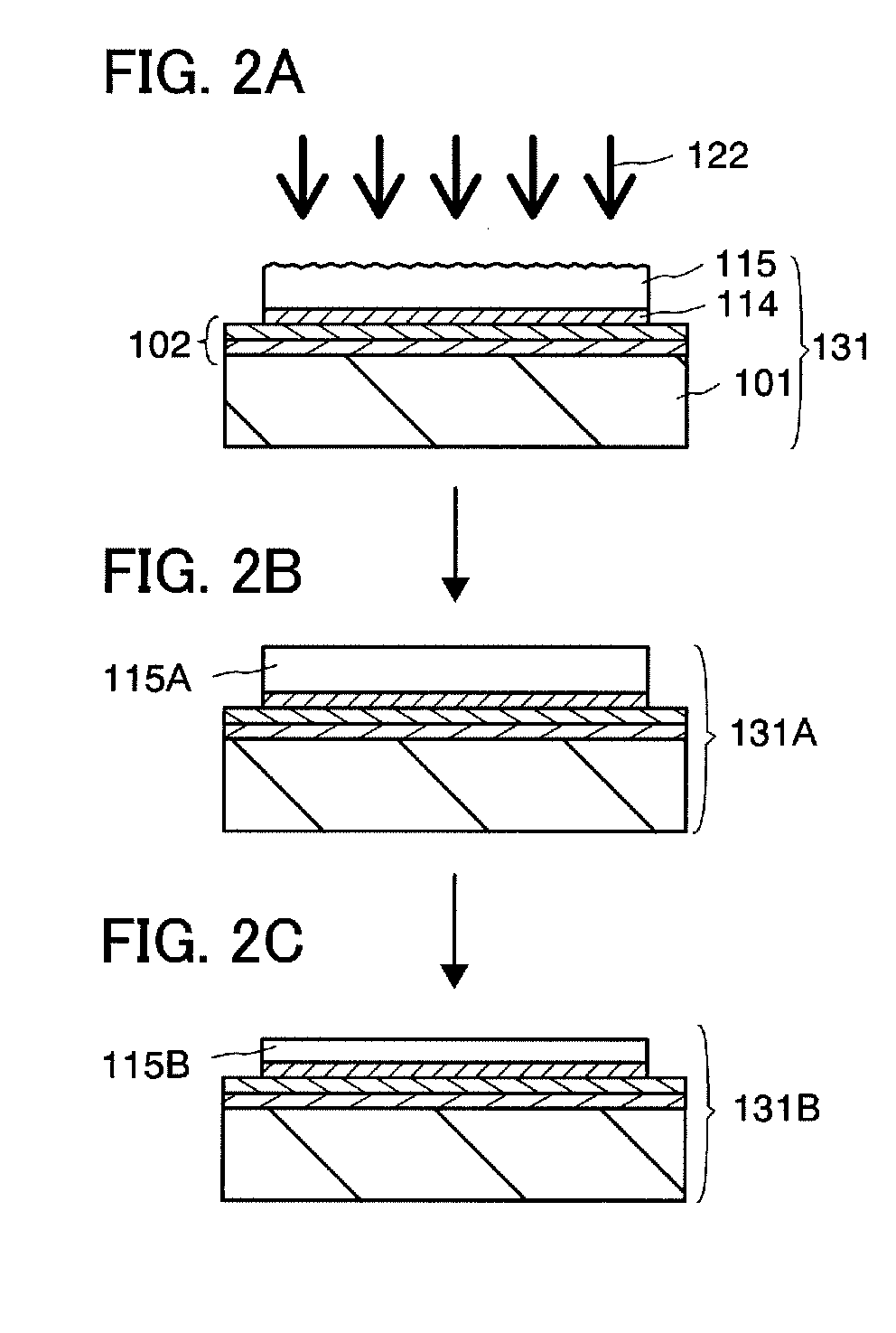Semiconductor device and electronic appliance
a technology of semiconductor devices and electronic appliances, applied in the direction of semiconductor devices, basic electric elements, electrical appliances, etc., can solve the problems of low heat resistance of semiconductor devices, temperature limitation to 700°, and inability to heat at temperatures, etc., and achieve the effect of expanding the area
- Summary
- Abstract
- Description
- Claims
- Application Information
AI Technical Summary
Benefits of technology
Problems solved by technology
Method used
Image
Examples
embodiment mode 1
[0057]FIGS. 1A to 1H and FIGS. 2A to 2C are cross-sectional views showing an example of a method for manufacturing an SOI substrate used for a semiconductor device of the present invention. An example of a method for manufacturing an SOI substrate will be described below using FIGS. 1A to 1H and FIGS. 2A to 2C.
[0058]First, a base substrate 101 is prepared (see FIG. 1A). As the base substrate 101, a light-transmitting glass substrate which is used for an electronic product such as a liquid crystal display device can be used. It is preferable to use, as the glass substrate, a substrate having a coefficient of thermal expansion which is greater than or equal to 2.5×10−6 / ° C. and less than or equal to 5.0×10−6 / ° C. (preferably, greater than or equal to 3.0×10−6 / ° C. and less than or equal to 4.0×10−6 / ° C.) and a strain point which is equal to or higher than 580° C. and equal to or lower than 680° C. (preferably, equal to or higher than 600° C. and equal to or lower than 680° C.) in term...
embodiment mode 2
[0150]FIGS. 5A to 5H and FIGS. 6A to 6C are cross-sectional views showing another example of the method for manufacturing an SOI substrate used for the semiconductor device of the present invention. Another example of the method for manufacturing an SOI substrate will be described below using FIGS. 5A to 5H and FIGS. 6A to 6C.
[0151]As described in Embodiment mode 1 using FIG. 1A, the base substrate 101 which serves as a base substrate of an SOI substrate is prepared (see FIG. 5A), and the insulating layer 102 is formed over the base substrate 101. Also in this embodiment mode, the insulating layer 102 is a two-layer film of the silicon nitride oxide film 103 and the silicon oxynitride film 104. Next, a bonding layer 105 is formed over the insulating layer 102 (see FIG. 5B). This bonding layer 105 can be formed in a similar manner to the bonding layer 114 formed over the semiconductor substrate 111, described in Embodiment Mode 1 or 2.
[0152]FIGS. 5C to 5E show the same process as sho...
embodiment mode 4
[0166]In each of Embodiment Modes 1 to 3, before the irradiation of the semiconductor layer 115 with the laser beam 122, a thinning step in which the semiconductor layer 115 is thinned by etching treatment (or etch-back treatment) can be performed. In the case of using an ion doping apparatus for the formation of the embrittlement layer 113, it is difficult to control the thickness of the semiconductor layer 115 to less than or equal to 100 nm. Therefore, the semiconductor layer 115 just after the separation is relatively thick. When the semiconductor layer 115 is thick, the irradiation energy density of the laser beam 122 needs to be high, and accordingly, the applicable range of the irradiation energy density becomes narrower, and it becomes difficult to planarize the semiconductor layer 115 and recover crystallinity of the semiconductor layer 115 with high yield by irradiation with the laser beam 122.
[0167]Therefore, when the thickness of the semiconductor layer 115 exceeds 200 n...
PUM
 Login to View More
Login to View More Abstract
Description
Claims
Application Information
 Login to View More
Login to View More - R&D
- Intellectual Property
- Life Sciences
- Materials
- Tech Scout
- Unparalleled Data Quality
- Higher Quality Content
- 60% Fewer Hallucinations
Browse by: Latest US Patents, China's latest patents, Technical Efficacy Thesaurus, Application Domain, Technology Topic, Popular Technical Reports.
© 2025 PatSnap. All rights reserved.Legal|Privacy policy|Modern Slavery Act Transparency Statement|Sitemap|About US| Contact US: help@patsnap.com



